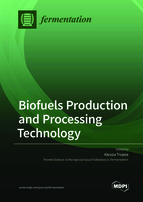Biofuels Production and Processing Technology
A special issue of Fermentation (ISSN 2311-5637). This special issue belongs to the section "Fermentation Process Design".
Deadline for manuscript submissions: closed (20 May 2022) | Viewed by 56708
Special Issue Editor
Interests: fermentation process management; biofuel; biorefinery; value-added products
Special Issues, Collections and Topics in MDPI journals
Special Issue Information
Dear Colleagues,
The negative global warming impact and global environmental pollution due to fossil fuels mean that the main challenge of modern society is finding alternatives to conventional fuels. In this scenario, biofuels derived from renewable biomass represent the most promising renewable energy sources. Depending on the biomass used by the fermentation technologies, it is possible obtain first-generation biofuels produced from food crops, second-generation biofuels produced from non-food feedstocks, mainly starting from renewable lignocellulosic biomasses, and third-generation biofuels, represented by algae or food waste biomass.
Although biofuels appear to be the closest alternative to fossil fuels, it is necessary for them to be produced in competitive quantities and costs, requiring both improvements to production technologies and diversification of feedstock.
This Special Issue will focus on technological innovations which include but are not limited to the utilization of different feedstocks, different biomass pretreatments, fermentation strategies such as SSF or SHF, different applied microorganisms used as monoculture or coculture, and different setups for biofuel fermentation processes.
Therefore, I would like to invite authors to submit original innovative research articles and review papers related to the potential topics of the “Biofuels Production and Processing Technology” Special Issue.
Dr. Alessia Tropea
Guest Editor
Manuscript Submission Information
Manuscripts should be submitted online at www.mdpi.com by registering and logging in to this website. Once you are registered, click here to go to the submission form. Manuscripts can be submitted until the deadline. All submissions that pass pre-check are peer-reviewed. Accepted papers will be published continuously in the journal (as soon as accepted) and will be listed together on the special issue website. Research articles, review articles as well as short communications are invited. For planned papers, a title and short abstract (about 100 words) can be sent to the Editorial Office for announcement on this website.
Submitted manuscripts should not have been published previously, nor be under consideration for publication elsewhere (except conference proceedings papers). All manuscripts are thoroughly refereed through a single-blind peer-review process. A guide for authors and other relevant information for submission of manuscripts is available on the Instructions for Authors page. Fermentation is an international peer-reviewed open access monthly journal published by MDPI.
Please visit the Instructions for Authors page before submitting a manuscript. The Article Processing Charge (APC) for publication in this open access journal is 2600 CHF (Swiss Francs). Submitted papers should be well formatted and use good English. Authors may use MDPI's English editing service prior to publication or during author revisions.
Keywords
- Biofuel production technologies
- Downstream processing
- Biorefinery
- Energy
- Bioethanol production
- Agroforest and industrial waste feedstock valorization
- Microorganisms for biofuel
Related Special Issue
- Biofuels Production and Processing Technology 2.0 in Fermentation (10 articles)






